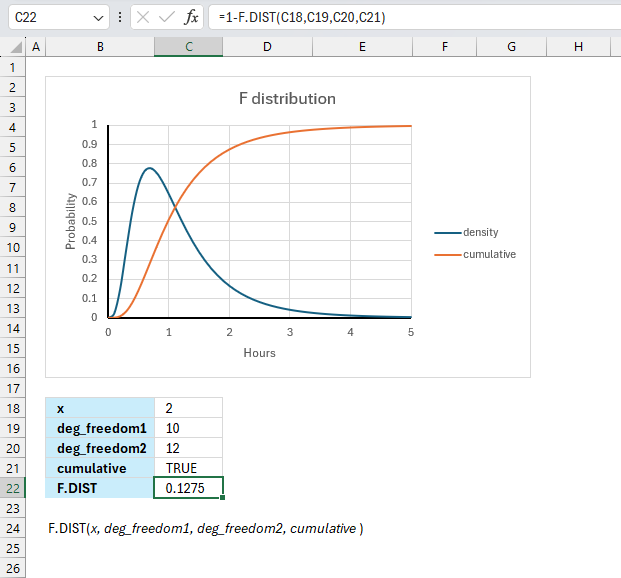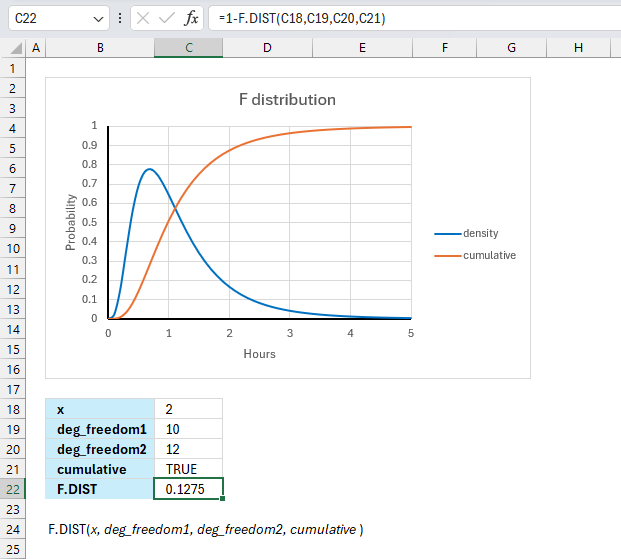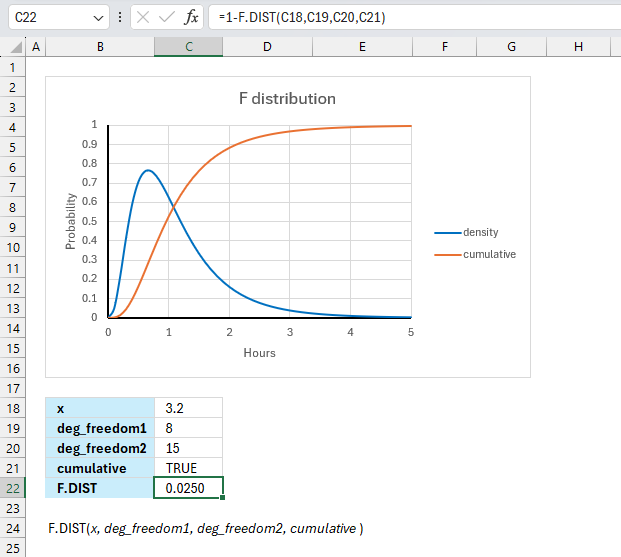How to use the F.DIST function

What is the F.DIST function?
The F.DIST function calculates the F probability for two tests. This function was introduced in Excel 2010 and has replaced the FDIST function.
The F.DIST function lets you find out if the means between two given populations are significantly different.
Table of Contents
1. Introduction
What is the F probability?
The F-distribution or F-ratio is a continuous probability distribution that compare the variances of two populations.
What is variance?
The variance shows how much a set of numbers are spread out from their average value.
Σ(x- x̄)2/(n-1)
x̄ is the sample mean
n is the sample size.
What is a null distribution?
The null hypothesis in the F-distribution is that two independent normal variances are equal. If the observed ratio is too large or too small, then the null hypothesis is rejected, and we conclude that the variances are not equal.
When is a f-distribution used?
The F-distribution is used in the F-test in analysis of variance comparing two variances, as the distribution of the ratio of sample variances when the null is true of no difference between population variances.
What is a continuous probability distribution?
A continuous probability distribution is defined over an interval and range of continuous values, giving the probability an outcome is exactly equal to any value, and having an area under its probability density curve equal to 1.
2. Syntax
F.DIST(x, deg_freedom1, deg_freedom2, cumulative)
3. Arguments
| x | Required. |
| deg_freedom1 | Required. Degrees of freedom (numerator). |
| deg_freedom2 | Required. Degrees of freedom (denominator). |
| cumulative | Required. A boolean value. TRUE - Cumulative distribution function. FALSE - Probability density function. |
What are the degrees of freedom?
The degrees of freedom parameters are the numerator and denominator chi-squared distributions. They form the ratio that follows the F-distribution.
The degrees of freedom parameters affect the shape of the F-distribution curve and probability, they relate to the samples and capture the amount of information in the variance estimates.
What is a chi-squared distribution?
A chi-squared distribution is a type of probability distribution that is used in statistical tests that compare the variances of two populations. The chi-squared distribution has one parameter, called degrees of freedom, that determines its shape and location. The degrees of freedom represent the number of independent pieces of information used to estimate the variances.
4. Example 1

In a statistical experiment, the variances of two independent samples are 25 and 16, with 10 and 12 degrees of freedom, respectively. What is the probability that the ratio of the variances is greater than 2?
The F-distribution is used to compare the variances of two independent normal populations. The F-statistic is calculated as the ratio of the two variances: F = variance1 / variance2. In this case, F = 25 / 16 = 1.5625.
How to determine the numerator and denominator degrees of freedom in a F distribution?
- The numerator degrees of freedom corresponds to the one with the greater variance (25) which is 10.
- The denominator degrees of freedom corresponds to the with the smaller variance (16), which is 12.
Here are the arguments for the F.DIST function:
- Cell C18 contains the specified x value, in this case 2
- Cell C19 contains the numerator degrees of freedom which is 10
- Cell C20 contain the denominator degrees of freedom which is 12
- Cell C21 contains the cumulative argument which is TRUE in this example.
Formula in cell C22:
The F.DIST function returns 0.872 however we want the complement meaning the area below the blue line in the image above from x value 2 to infinity. To calculate the complement we subtract 1 - 0.872 = 0.1275 (12.75%).
In the image, locate the value 2 on the x-axis. From that point, draw an imaginary vertical line upwards until it intersects with the orange curve, which represents the cumulative distribution function. Then, follow the point of intersection horizontally towards the y-axis. You will find that the corresponding value on the y-axis is approximately 0.87.
5. Example 2

A researcher wants to compare the means of two populations based on two independent samples. If the F-statistic calculated from the sample data is 3.2 with 8 and 15 degrees of freedom, what is the probability of obtaining an F-value greater than or equal to 3.2?
How to determine the numerator and denominator degrees of freedom in a F distribution?
- The numerator degrees of freedom corresponds to the one with the greater variance which is 8.
- The denominator degrees of freedom corresponds to the with the smaller variance which is 15.
Here are the arguments for the F.DIST function:
- Cell C18 contains the specified x value, in this case 3.2
- Cell C19 contains the numerator degrees of freedom which is 8
- Cell C20 contain the denominator degrees of freedom which is 15
- Cell C21 contains the cumulative argument which is TRUE in this example.
Formula in cell C22:
The F.DIST function returns 0.975 however we want the complement meaning the area below the blue line in the image above from x value 3.2 to infinity. To calculate the complement we subtract 1 - 0.975 = 0.025 (2.5%).
In the image, locate the value 3.2 on the x-axis. From that point, draw an imaginary vertical line upwards until it intersects with the orange curve, which represents the cumulative distribution function. Then, follow the point of intersection horizontally towards the y-axis. You will find that the corresponding value on the y-axis is approximately 0.97.
6. Function not working

The F.DIST function returns
- #VALUE! error value if any argument is non-numeric.
- #NUM! error value if:
- x < 0 (zero)
- deg_freedom1 < 1
- deg_freedom2 < 1
deg_freedom1 and deg_freedom2 will be converted into integers if they are not.
6.1 Troubleshooting the error value

When you encounter an error value in a cell a warning symbol appears, displayed in the image above. Press with mouse on it to see a pop-up menu that lets you get more information about the error.
- The first line describes the error if you press with left mouse button on it.
- The second line opens a pane that explains the error in greater detail.
- The third line takes you to the "Evaluate Formula" tool, a dialog box appears allowing you to examine the formula in greater detail.
- This line lets you ignore the error value meaning the warning icon disappears, however, the error is still in the cell.
- The fifth line lets you edit the formula in the Formula bar.
- The sixth line opens the Excel settings so you can adjust the Error Checking Options.
Here are a few of the most common Excel errors you may encounter.
#NULL error - This error occurs most often if you by mistake use a space character in a formula where it shouldn't be. Excel interprets a space character as an intersection operator. If the ranges don't intersect an #NULL error is returned. The #NULL! error occurs when a formula attempts to calculate the intersection of two ranges that do not actually intersect. This can happen when the wrong range operator is used in the formula, or when the intersection operator (represented by a space character) is used between two ranges that do not overlap. To fix this error double check that the ranges referenced in the formula that use the intersection operator actually have cells in common.
#SPILL error - The #SPILL! error occurs only in version Excel 365 and is caused by a dynamic array being to large, meaning there are cells below and/or to the right that are not empty. This prevents the dynamic array formula expanding into new empty cells.
#DIV/0 error - This error happens if you try to divide a number by 0 (zero) or a value that equates to zero which is not possible mathematically.
#VALUE error - The #VALUE error occurs when a formula has a value that is of the wrong data type. Such as text where a number is expected or when dates are evaluated as text.
#REF error - The #REF error happens when a cell reference is invalid. This can happen if a cell is deleted that is referenced by a formula.
#NAME error - The #NAME error happens if you misspelled a function or a named range.
#NUM error - The #NUM error shows up when you try to use invalid numeric values in formulas, like square root of a negative number.
#N/A error - The #N/A error happens when a value is not available for a formula or found in a given cell range, for example in the VLOOKUP or MATCH functions.
#GETTING_DATA error - The #GETTING_DATA error shows while external sources are loading, this can indicate a delay in fetching the data or that the external source is unavailable right now.
6.2 The formula returns an unexpected value

To understand why a formula returns an unexpected value we need to examine the calculations steps in detail. Luckily, Excel has a tool that Here is how to troubleshoot a formula:
- Select the cell containing the formula you want to examine in detail.
- Go to tab “Formulas” on the ribbon.
- Press with left mouse button on "Evaluate Formula" button. A dialog box appears.
The formula appears in a white field inside the dialog box. Underlined expressions are calculations being processed in the next step. The italicized expression is the most recent result. The buttons at the bottom of the dialog box allows you to evaluate the formula in smaller calculations which you control. - Press with left mouse button on the "Evaluate" button located at the bottom of the dialog box to process the underlined expression.
- Repeat pressing the "Evaluate" button until you have seen all calculations step by step. This allows you to examine the formula in greater detail and hopefully find the culprit.
- Press "Close" button to dismiss the dialog box.

There is also another way to debug formulas using the function key F9. F9 is especially useful if you have a feeling that a specific part of the formula is the issue, this makes it faster than the "Evaluate Formula" tool since you don't need to go through all calculations to find the issue..
- Enter Edit mode: Double-press with left mouse button on the cell or press F2 to enter Edit mode for the formula.
- Select part of the formula: Highlight the specific part of the formula you want to evaluate. You can select and evaluate any part of the formula that could work as a standalone formula.
- Press F9: This will calculate and display the result of just that selected portion.
- Evaluate step-by-step: You can select and evaluate different parts of the formula to see intermediate results.
- Check for errors: This allows you to pinpoint which part of a complex formula may be causing an error.
The image above shows cell reference C2 converted to hard-coded value using the F9 key. The value is a text value, however, the F.DIST function requires a numerical value. We have found what is wrong with the formula.
Tips!
- View actual values: Selecting a cell reference and pressing F9 will show the actual values in those cells.
- Exit safely: Press Esc to exit Edit mode without changing the formula. Don't press Enter, as that would replace the formula part with the calculated value.
- Full recalculation: Pressing F9 outside of Edit mode will recalculate all formulas in the workbook.
Remember to be careful not to accidentally overwrite parts of your formula when using F9. Always exit with Esc rather than Enter to preserve the original formula. However, if you make a mistake overwriting the formula it is not the end of the world. You can “undo” the action by pressing keyboard shortcut keys CTRL + z or pressing the “Undo” button
Other errors
Floating-point arithmetic may give inaccurate results in Excel - Article
Floating-point errors are usually very small, often beyond the 15th decimal place, and in most cases don't affect calculations significantly.
Functions in 'Statistical' category
The F.DIST function function is one of 73 functions in the 'Statistical' category.
How to comment
How to add a formula to your comment
<code>Insert your formula here.</code>
Convert less than and larger than signs
Use html character entities instead of less than and larger than signs.
< becomes < and > becomes >
How to add VBA code to your comment
[vb 1="vbnet" language=","]
Put your VBA code here.
[/vb]
How to add a picture to your comment:
Upload picture to postimage.org or imgur
Paste image link to your comment.
Contact Oscar
You can contact me through this contact form